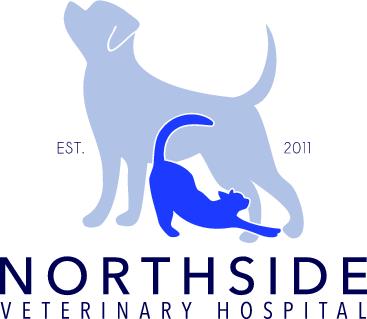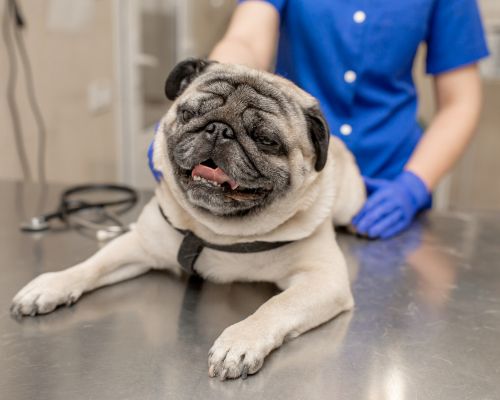Pet Soft Palate and Nares
Learn more about our pet soft palate and nares services below.
Pet Soft Palate and Nares in Shawnee, OK
Certain dog breeds have a short head shape, narrow windpipe, and excessive soft tissues at the throat’s back that cause breathing obstruction.
Brachycephalic Syndrome
The brachycephalic (squashed faces) breeds are the most commonly affected dogs. They include:
- Pug
- French bulldog
- Boxer
- Boston terrier
- Pekingese
- English bulldogs
- American Staffordshire Terrier
- Staffordshire Bull Terriers
- Cavalier King Charles Spaniels
- Affenpinscher
- Rottweiler
- Bullmastiff
- American Bulldog
These dog breeds have relatively short noses and muzzles, and their throat and breathing passages are flattened. Other structural issues contributing to this include narrow nostrils, excessively long soft palate (the tissue towards the back of the mouth separating the nose from the mouth), the collapse of the larynx (the cartilages that open and close the upper airway), or laryngeal cartilage paralysis. This condition is known as Brachycephalic obstructive airway syndrome (BOAS).
These structural abnormalities make breathing difficult due to partly blocked or small breathing structures. Old age also worsens these problems due to extra pressure on the throat from difficulty breathing, leading to swelling and collapsing of other structures. Persian cats are also affected by this condition.
Brachycephalic obstructive airway syndrome can also cause other problems, such as:
- Gastroesophageal reflux (flow back of intestinal fluids into the esophagus)
- Chronic gastritis
- Bronchial collapse
Signs and Symptoms
Clinical signs and symptoms include:
- Noisy breathing, especially when inhaling
- Snoring
- Gagging
- Exercise intolerance
- Regurgitation
- Coughing
- Panting loudly
- Collapsing after strenuous exercise
- Vomiting/ regurgitation
- Difficulty breathing
Hot weather, stress, being overweight, and over-excitement cause symptoms to flare up and make them struggle to breathe. Some dogs sleep on their back to alleviate blockage in the air passages since the extra tissues lie back.
If your dog is having difficulty breathing or has a purple or dark red tongue, it needs to be hospitalized immediately to be given sedatives, anti-inflammatories, and oxygen. Some emergency cases require a breathing tube.
Diagnosis
BOAS can be diagnosed during a routine physical examination. Narrow nostrils can be identified by looking into the dog’s nose, while a narrow windpipe and chest examination require an X-ray.
Your dog’s mouth and throat may be examined under general anesthesia to check for enlarged tonsils, the collapse of throat structures, and a long soft palate. If your puppy is genetically predisposed to BOAS, you can get their mouth and throat examined at desexing to look out for the issues mentioned above. The problems can be corrected at that time or at a later time.
Treatment
Breathing problems must be treated as soon as possible since they can be fatal. Weight loss is essential if your dog is overweight. Mild signs can be conservatively managed by avoiding hot or humid environments, exercising, avoiding stress, and keeping your dog in air conditioning during summer.
For short-term relief, your vet may prescribe corticosteroids, nonsteroidal anti-inflammatory drugs (NSAIDs), and oxygen therapy for respiratory distress. However, medication does not correct the underlying condition of structural abnormalities.
For exercise intolerance, difficulty breathing, coughing, gagging, and stenotic nares, resection of the excess soft palate (staphylectomy) is performed to remove excess tissue. This improves the breathing function of your dog.
Surgery can correct several cases of BAOS whenever structural abnormalities interfere with breathing. Removal of tonsils or other structures is required in severe cases where the airway is blocked.
After surgery, minor swelling may occur, interfering with breathing. Your veterinarian will closely monitor your dog post-surgery, and you will receive postoperative care instructions once discharged. Dogs with BOAS should be fitted with a harness that doesn’t tug around the neck area since it can put pressure on the neck. Dogs with breathing difficulties should not be used for breeding. The dogs should be neutered or spayed while they are having surgery to correct BOAS.
Early treatment of BOAS is essential in preventing further complications and other abnormalities.
Prognosis
Prognosis depends on the severity of the condition, how many abnormalities are present, and the age of the dog. Younger dogs (under two years of age) have a better prognosis and can participate in more physical activities than older ones. The lesser the defects, the better the prognosis. In very advanced cases, recovery is poor. The prognosis is poorer in case of secondary problems from airway distress or other problems.
With appropriate management and early detection, your dog can live normally and have an improved quality of life.
At Northside Veterinary Hospital, we can properly diagnose and effectively treat your pet if it has a soft palate and nares or other disorders. Our highly experienced veterinary surgeons are ready to answer any questions about your pet’s condition. For more information, please schedule an appointment or contact us today. We are glad to help.

